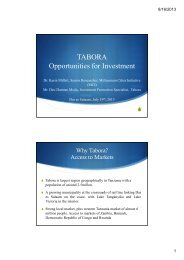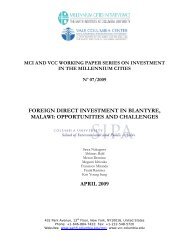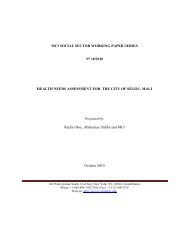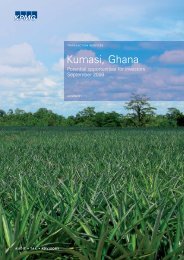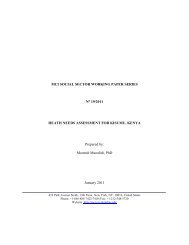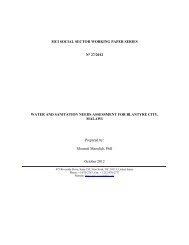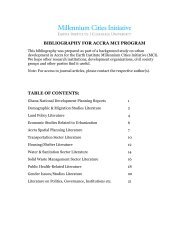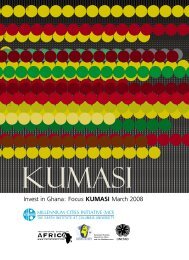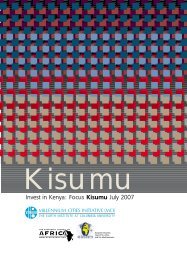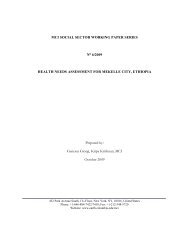Mekelle, Ethiopia - Millennium Cities Initiative - Columbia University
Mekelle, Ethiopia - Millennium Cities Initiative - Columbia University
Mekelle, Ethiopia - Millennium Cities Initiative - Columbia University
Create successful ePaper yourself
Turn your PDF publications into a flip-book with our unique Google optimized e-Paper software.
There is high potential<br />
for supply of Tigray<br />
honey to Europe and<br />
the Middle East.<br />
In spite of its favourable natural conditions<br />
and large bee population, up until 2007,<br />
<strong>Ethiopia</strong> was a negligible supplier of<br />
honey to international markets. Almost<br />
the entire honey volume produced was<br />
consumed locally (mainly for production<br />
as a local wine). A very small amount of<br />
honey was exported to Sudan and Middle<br />
East markets.<br />
Until 2008, the European market was<br />
closed for <strong>Ethiopia</strong>n honey producers.<br />
As indicated in an interview with a<br />
representative of the Honey and Beeswax<br />
Producers and Exporters Association,<br />
<strong>Ethiopia</strong> became an accredited country for<br />
supplying honey to the EU in 2008.<br />
In 2008, revenues from honey export<br />
from <strong>Ethiopia</strong> to the EU amounted to<br />
USD120 thousand (98 percent of which<br />
was exported to the UK).<br />
The EU, Yemen, Israel and UAE can be<br />
considered as the major potential target<br />
markets for <strong>Ethiopia</strong>n honey. The import<br />
of honey into these markets has been<br />
increasing steadily over the last five years<br />
and is expected to continue to increase<br />
within the next two to three years.<br />
Beeswax production<br />
and export can be<br />
considered as a<br />
potential opportunity<br />
in the short term,<br />
but does not appear<br />
attractive in the mid<br />
and long term.<br />
Although <strong>Ethiopia</strong> is currently one of the<br />
largest beeswax exporters in the world,<br />
beeswax opportunities in Tigray State<br />
appear to be limited in the mid and long<br />
term due to the ongoing replacement of<br />
traditional with modern hives.<br />
<strong>Mekelle</strong>, <strong>Ethiopia</strong>: Potential Opportunities for Investment 37<br />
Despite the fact that modern hives can<br />
produce 5–10 times more honey than<br />
traditional ones, the wax yield from modern<br />
hives is 0.5–2 percent compared to 8–10<br />
percent for traditional hives.<br />
<strong>Ethiopia</strong>n honey export dynamics and structure, (2005–2008)<br />
400<br />
350<br />
300<br />
250<br />
KT<br />
200<br />
150<br />
100<br />
50<br />
0<br />
USD0.04m USD0.54m<br />
387<br />
196<br />
10<br />
2005 2006 2007 2008<br />
Source: 1. UN Comtrade, 20045-2008<br />
53<br />
The local market for<br />
honey also shows<br />
significant potential<br />
for investors.<br />
However, the<br />
domestic market is<br />
not as attractive for<br />
processed honey as<br />
foreign markets.<br />
Local demand is mainly for raw honey,<br />
not the value-add processed honey which<br />
commands a higher price.<br />
The majority of honey for local consumption<br />
is distributed through traditional markets.<br />
72%<br />
15%<br />
12%<br />
1%<br />
Sudan<br />
EU<br />
Middle East<br />
© 2010 KPMG International Cooperative (“KPMG International”), a Swiss entity. Member firms of the KPMG network of independent firms are affiliated with KPMG International. KPMG<br />
International provides no client services. No member firm has any authority to obligate or bind KPMG International or any other member firm vis-à-vis third parties, nor does KPMG<br />
International have any such authority to obligate or bind any member firm. All rights reserved.<br />
Other



